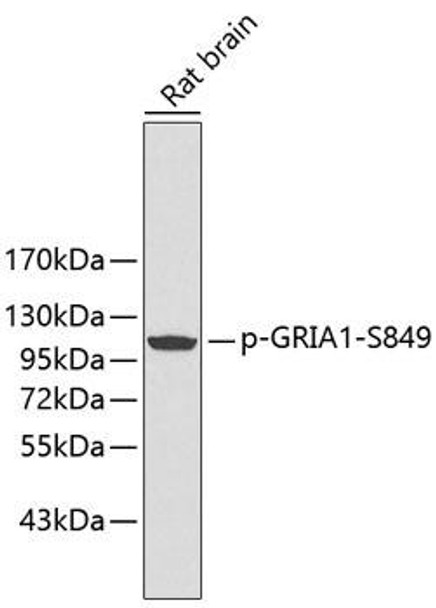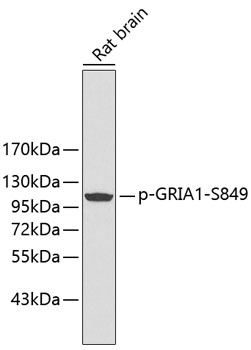Signal Transduction Antibodies 3
Anti-Phospho-GRIA1-S849 Antibody (CABP0242)
- SKU:
- CABP0242
- Product Type:
- Antibody
- Applications:
- WB
- Reactivity:
- Human
- Reactivity:
- Mouse
- Reactivity:
- Rat
- Host Species:
- Rabbit
- Isotype:
- IgG
- Research Area:
- Signal Transduction
Description
| Antibody Name: | Anti-Phospho-GRIA1-S849 Antibody |
| Antibody SKU: | CABP0242 |
| Antibody Size: | 50uL, 100uL |
| Application: | WB |
| Reactivity: | Human, Mouse, Rat |
| Host Species: | Rabbit |
| Immunogen: | A phospho specific peptide corresponding to residues surrounding S849 of human GRIA1 |
| Application: | WB |
| Recommended Dilution: | WB 1:500 - 1:2000 |
| Reactivity: | Human, Mouse, Rat |
| Positive Samples: | Rat brain |
| Immunogen: | A phospho specific peptide corresponding to residues surrounding S849 of human GRIA1 |
| Purification Method: | Affinity purification |
| Storage Buffer: | Store at -20°C. Avoid freeze / thaw cycles. Buffer: PBS with 0.02% sodium azide, 50% glycerol, pH7.3. |
| Isotype: | IgG |
| Sequence: | Email for sequence |
| Gene ID: | 2890 |
| Uniprot: | P42261 |
| Cellular Location: | Cell junction, Cell membrane, Cell projection, Endoplasmic reticulum membrane, Multi-pass membrane protein, dendrite, dendritic spine, postsynaptic cell membrane, postsynaptic density, synapse |
| Calculated MW: | 92kDa/93kDa/101kDa/102kDa |
| Observed MW: | 102kDa |
| Synonyms: | GRIA1, GLUH1, GLUR1, GLURA, GluA1, HBGR1, GluR1 |
| Background: | Glutamate receptors are the predominant excitatory neurotransmitter receptors in the mammalian brain and are activated in a variety of normal neurophysiologic processes. These receptors are heteromeric protein complexes with multiple subunits, each possessing transmembrane regions, and all arranged to form a ligand-gated ion channel. The classification of glutamate receptors is based on their activation by different pharmacologic agonists. This gene belongs to a family of alpha-amino-3-hydroxy-5-methyl-4-isoxazole propionate (AMPA) receptors. Alternatively spliced transcript variants encoding different isoforms have been found for this gene. |
| UniProt Protein Function: | GluR1: an integral membrane protein belonging to the glutamate-gated ion channel family. L-glutamate (Glu) acts as an excitatory neurotransmitter at many synapses in the central nervous system. Glutamate receptors are heteromeric protein complexes with multiple subunits, each possessing transmembrane regions, and all arranged to form a ligand-gated ion channel. The postsynaptic actions of Glu are mediated by a variety of receptors that are named according to their selective agonists. Each of the four GluR proteins (GRIA1-4) include flip and flop isoforms generated by alternative RNA splicing. Expressed in granule and pyramidal cells in the hippocampal formation. |
| UniProt Protein Details: | Protein type:Membrane protein, integral; Membrane protein, multi-pass; Channel, calcium; Channel, ligand-gated Chromosomal Location of Human Ortholog: 5q31.1 Cellular Component: cell junction; cell soma; cell surface; dendrite; dendritic spine; endoplasmic reticulum membrane; ER-Golgi intermediate compartment membrane; Golgi membrane; plasma membrane; postsynaptic density; postsynaptic membrane; recycling endosome; synaptic vesicle Molecular Function:alpha-amino-3-hydroxy-5-methyl-4-isoxazole propionate selective glutamate receptor activity; extracellular-glutamate-gated ion channel activity; glutamate receptor activity; PDZ domain binding; protein binding Biological Process: cellular protein metabolic process; COPII coating of Golgi vesicle; ER to Golgi vesicle-mediated transport; ionotropic glutamate receptor signaling pathway; long-term memory; post-translational protein modification; protein amino acid N-linked glycosylation via asparagine; receptor internalization; signal transduction; synaptic transmission |
| NCBI Summary: | Glutamate receptors are the predominant excitatory neurotransmitter receptors in the mammalian brain and are activated in a variety of normal neurophysiologic processes. These receptors are heteromeric protein complexes with multiple subunits, each possessing transmembrane regions, and all arranged to form a ligand-gated ion channel. The classification of glutamate receptors is based on their activation by different pharmacologic agonists. This gene belongs to a family of alpha-amino-3-hydroxy-5-methyl-4-isoxazole propionate (AMPA) receptors. Alternatively spliced transcript variants encoding different isoforms have been found for this gene. [provided by RefSeq, Jul 2008] |
| UniProt Code: | P42261 |
| NCBI GenInfo Identifier: | 116242505 |
| NCBI Gene ID: | 2890 |
| NCBI Accession: | P42261.2 |
| UniProt Secondary Accession: | P42261,Q2NKM6, B7Z2S0, B7Z2W8, B7Z3F6, B7Z9G9, D3DQI4 E7ESV8, |
| UniProt Related Accession: | P42261 |
| Molecular Weight: | 102,864 Da |
| NCBI Full Name: | Glutamate receptor 1 |
| NCBI Synonym Full Names: | glutamate ionotropic receptor AMPA type subunit 1 |
| NCBI Official Symbol: | GRIA1 |
| NCBI Official Synonym Symbols: | GLUH1; GLUR1; GLURA; GluA1; HBGR1 |
| NCBI Protein Information: | glutamate receptor 1 |
| UniProt Protein Name: | Glutamate receptor 1 |
| UniProt Synonym Protein Names: | AMPA-selective glutamate receptor 1; GluR-A; GluR-K1; Glutamate receptor ionotropic, AMPA 1; GluA1 |
| UniProt Gene Name: | GRIA1 |
| UniProt Entry Name: | GRIA1_HUMAN |







